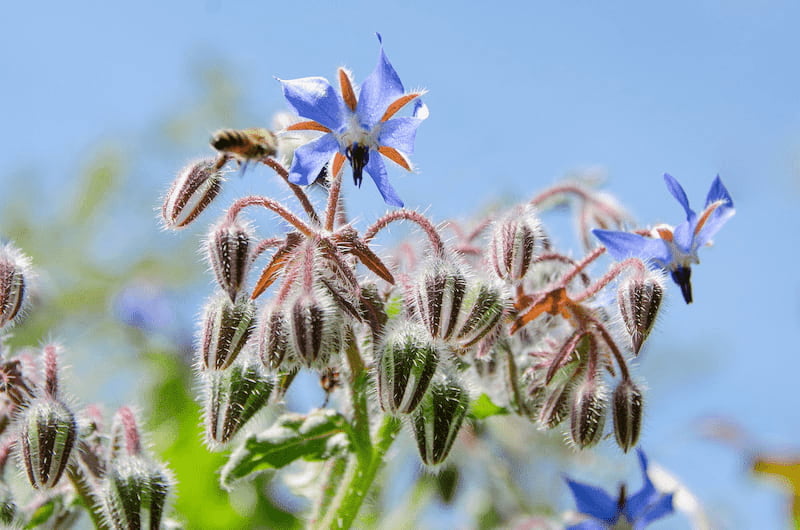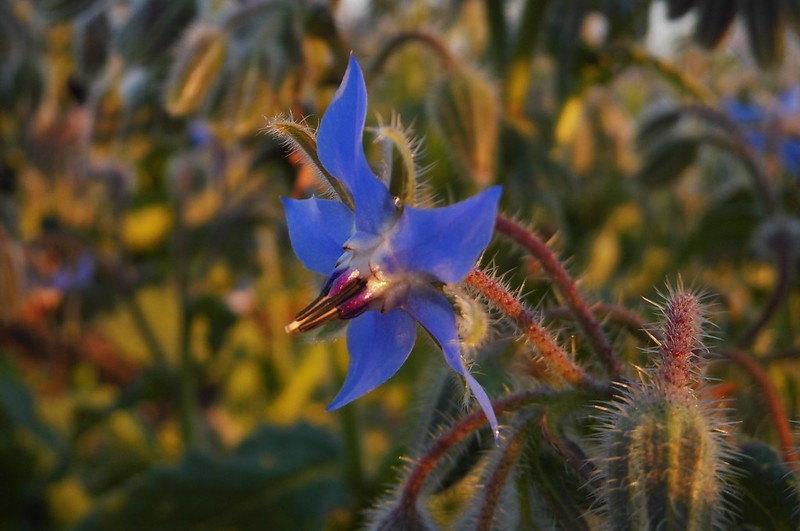Used since antiquity for its medicinal properties, borage (Borago officinalis) is considered by some as an adventive plant found wild around the Mediterranean. Yet, borage fully deserves its place in the vegetable garden for its benefits to our wellbeing, or even in flower beds, as its small star-shaped flowers display a magnificent azure blue. These flowers are also highly melliferous and appreciated by pollinating insects. Moreover, it requires very little attention and care and self-seeds year after year (at the risk of becoming invasive!). The leaves and flowers of borage can be used fresh in cooking or cosmetics. They can also be dried. Discover all our tips on when and how to dry borage.
The ideal time to harvest borage
With borage, every part is useful! Indeed, you can harvest the leaves, stems and flowers. This "happy plant" has many virtues for general wellbeing and skin health. Whichever part of the plant interests you, harvest in the early morning, once the dew has dried, on a sunny day. The key is to harvest your borage before the sun's rays become too hot.

The stems, leaves and flowers of borage can be dried
As for the harvesting period, it spans from May to September, during the flowering of this herbaceous plant from the Boraginaceae family. However, if you only wish to harvest the leaves, do so just before the full bloom of the small star-shaped flowers.
You can cut with scissors or secateurs either the entire plant, the flowering tops, or the small flowers one by one. The drying process will obviously differ depending on the parts collected.
How to dry borage?
Traditional air drying is always recommended to preserve borage's properties. If you've harvested flowering tops, make a bouquet by tying the stems with string or raffia and hang them upside down in a well-ventilated, dry room away from light. Do the same for the entire plant. After one or two weeks, they will be dry.
If you've only picked the pretty blue flowers, you'll need to spread them out on a flat surface like a tray, newspaper, or better yet a drying rack to allow proper air circulation. Space them sufficiently so they don't overlap. Again, store the flowers in a dry, ventilated place without direct sunlight. After a week, shake them to even out the drying. After 10 to 15 days, the borage flowers will be dry. Their bluish hue will still be slightly present.

Borage flowers tend to lose their azure blue colour when dried
If you don't have a sufficiently dry and ventilated room (like an attic), you can dry your borage in the oven at 50°C. Check the drying progress every 30 minutes. Allow 3 to 5 hours.
How to properly store dried borage?
Dried borage flowers and leaves should be stored in airtight glass containers or in a kraft paper bag. The key is to keep them dry and away from light.
How to use dried borage flowers and leaves?
Although fresh borage flowers or leaves retain their virtues better than dried ones, it's still beneficial to consume them dried. Particularly in herbal teas or steam inhalations. For an infusion, use 1g per cup of simmering water. Steep for 5 to 10 minutes. For a steam inhalation, throw two large handfuls of dried borage into a litre of boiling water and inhale.
Dried borage can also be used in cosmetics. You can make a macerate with 1/3 dried borage and 2/3 olive oil. Let it macerate for 6 weeks away from light at about 25°C. Strain and use as an oil to regenerate the skin and delay ageing. In India, women also infuse borage flowers in coconut milk to make a hair mask.

With dried borage flowers, you can make a macerate beneficial for the skin
The virtues of borage
Borage is beneficial for:
- facilitating healing and soothing sensitive, acne-prone skin or skin affected by psoriasis. It also promotes skin tone and reduces stretch marks.
- Stimulating kidney and liver function. Consume in moderation. Pregnant women should avoid.
- Soothing rheumatic pains.
To go further
- Discover our selection of 15 medicinal plants with numerous virtues... to grow in your garden!
- The most beautiful herb seeds are here with us!
































Comments